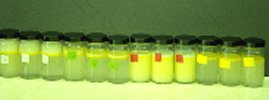| |
Oil Properties
Botanical oils vary in availability and in composition. The most abundant
botanical oil in the United States is soybean oil, thus most of our research
has been with that oil. Researchers in Australia, Europe, India, and South
America are researching the botanical oils available to them.
Soybean oil is refined by several methods
but the most common is by solvent extraction. Thus, botanical oil are
not described with distillation ranges as are the petroleum oils. Soybean
is available in crude, degummed, and refined forms. Most of our research
has been with the degummed form because it more uniform than the crude
oil and has been described as more stable in storage than refined oil.
Soybean oil must be mixed with an adjuvant
in order to mix in water. Most of our trials have used our TNsoy1 formulation
(a mixture of soybean oil with Latron B-1956 spreader-sticker at 10 oil
: 1 Latron (v/v)}).  It
is important to premix the oil and adjuvant at least 30 minutes prior
to adding to the spray water. A premixed oil/adjuvant formulation is more
effective than adding oil and adjuvant separately to the water in the
spray tank. It
is important to premix the oil and adjuvant at least 30 minutes prior
to adding to the spray water. A premixed oil/adjuvant formulation is more
effective than adding oil and adjuvant separately to the water in the
spray tank.
Wintertime sprays of TNsoy1 remain visible
of twigs for several weeks. However, foliar sprays in the summer can be
washed off by rain thus repeated sprays may be needed.
The type of soybean oil in a formulation
is one concern, however the adjuvant used with the oil is also important.
The adjuvant will influence formulation stability; oil contact, coverage
and retention on plant material; and phytotoxicity. We are evaluating
various adjuvants to use with soybean oil.
Properties Gallery

Abstracts: (pdf files require the Adobe
Acrobat plug-in)
Apple and peach leaf and stem surface morphology and soybean oil retention
as influenced by simulated rainfall and soybean oil emulsions.
pdf | html
Oil emulsions enhance transcuticular movement of captan into apple leaves.
pdf
| html
Wax morphology and gas exchange of peach and apple leaves as influenced
by soybean oil emulsions and rain In: pdf | html
Publications
|